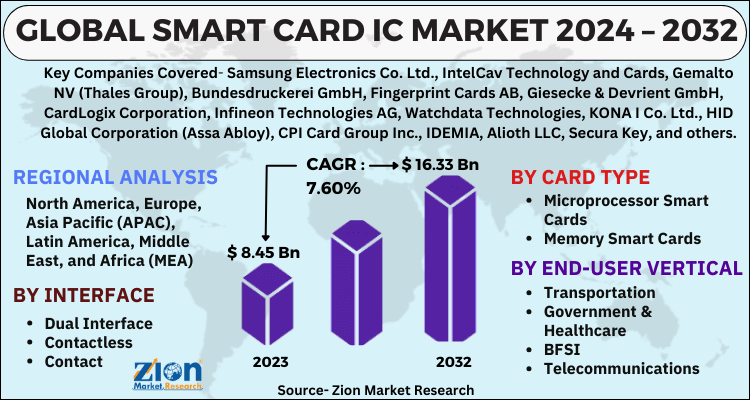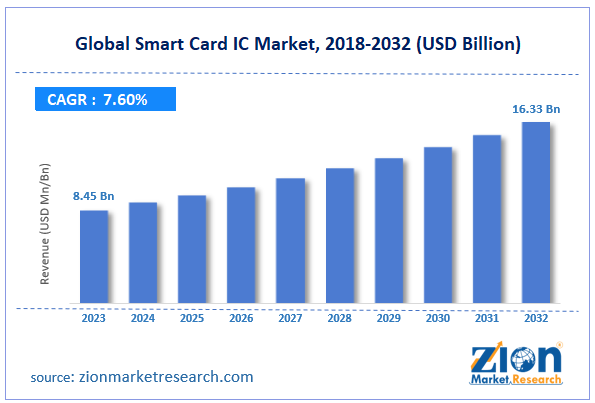Smart Card IC Market Size, Share, Trends, Growth 2032

Smart Card IC Market By Interface (Dual Interface, Contactless, and Contact), By Card Type (Microprocessor Smart Cards and Memory Smart Cards), By End-User Vertical (Transportation, Government & Healthcare, BFSI, Telecommunications, and Others), and By Region - Global and Regional Industry Overview, Market Intelligence, Comprehensive Analysis, Historical Data, and Forecasts 2024 - 2032
| Market Size in 2023 | Market Forecast in 2032 | CAGR (in %) | Base Year |
|---|---|---|---|
| USD 8.45 Billion | USD 16.33 Billion | 7.60% | 2023 |
Smart Card IC Industry Prospective:
The global smart card IC market size was worth around USD 8.45 billion in 2023 and is predicted to grow to around USD 16.33 billion by 2032 with a compound annual growth rate (CAGR) of roughly 7.60% between 2024 and 2032.
Smart Card IC Market: Overview
A smart card integrated circuit (IC) is a physical card equipped or embedded with an IC that performs as a security device. The size of a smart card IC in a typical scenario does not exceed that of a driver’s license or a social security card. It can either be made of plastic or metal depending on user preference. According to market analysis, smart cards have several applications in modern industries. For instance, one of the most common uses of a smart card integrated circuit is in the form of credit cards or debit cards.
Furthermore, they are also used in the telecommunication industry for storing subscriber information and connecting to mobile networks. The demand for smart card IC has been growing over the years especially fueled by the rising number of mobile phone users across the globe.
In addition to this, the hospitality industry is one of the leading consumers of smart card integrated circuits due to their ability to store and protect user information. During the forecast period, the increasing rate of innovation and security enhancement features will help fuel the revenue. However, market players must remain attentive to supply chain disruptions of raw materials required for producing smart card IC or the final products.
Key Insights:
- As per the analysis shared by our research analyst, the global smart card IC market is estimated to grow annually at a CAGR of around 7.60% over the forecast period (2024-2032)
- In terms of revenue, the global smart card IC market size was valued at around USD 8.45 billion in 2023 and is projected to reach USD 16.33 billion by 2032.
- The market is projected to grow at a significant rate due to the rising number of mobile phone users worldwide.
- Based on the interface, the dual interface segment is growing at a high rate and will continue to dominate the global market as per industry projections.
- Based on the end-user verticals, the telecommunications segment is anticipated to command the largest market share.
- Based on region, Asia-Pacific is projected to dominate the global market during the forecast period.
Smart Card IC Market: Growth Drivers
Rising number of mobile phone users worldwide to drive market demand rate
The global smart card IC market is projected to grow due to the rising number of mobile phone users across the globe. The Subscriber Identity Module (SIM) cards are one of the key components of a mobile phone for the device to perform its expected functions. For instance, a SIM card is essential for storing user information and other data that the user may feed into the system including contact list and call logs.
In addition to this, a SIM card is necessary for connecting the device to a network provider which facilitates outbound or inbound calls and messages. The surge in the number of mobile phone users is influenced by several factors. For instance, the consumer electronics industry is currently dominated by an extensive number of smartphone users.
In addition to this, several network providers have partnered with mobile phone companies to promote the sale of mobile phones and network services. In September 2024, T-Mobile announced the launch of a new partnership with Ericsson, NVIDIA, and Nokia as the company focuses on further strengthening its position in the 5G space. The partnership is expected to revolutionize the industry of radio access networks (RAN) using Artificial Intelligence (AI)-based solutions.
Furthermore, growing disposable income, changing consumer lifestyles, and innovation-backed mobile devices will impact the overall consumption of smart card integrated circuits.
Increasing applications in the banking & finance sector to promote industry growth rate
Smart card integrated circuits are widely used in the banking & finance industry. The information storing and protective device is used for enabling secure financial transactions using credit or debit cards. The surge in the number of financial card users worldwide will promote extensive revenue for the global smart card IC market.
According to the India Brand Equity Foundation (IBEF), the country marked 100 million active credit card users as of February 2024. Credit cards are exceptionally popular in developed economies. They are also gaining traction in emerging nations as consumer lifestyle continues to evolve. In addition to this, growing awareness about the benefits of using credit cards responsibly has improved in the last few years.
Smart Card IC Market: Restraints
Concerns related to supply chain disruptions may impact the overall revenue in the market
The global industry for smart card IC is projected to be restricted due to the concerns associated with the supply chain disruptions of raw materials required for producing the data-storing solution or the finished goods. Changes in geopolitical relationships and scarcity of raw materials may impact the final production rate of smart card ICs. Furthermore, although smart card ICs offer data protection and integrity, they are susceptible to cyber-attacks, especially against advanced hacking systems.
Smart Card IC Market: Opportunities
Increasing novel applications and technological innovation to generate growth opportunities
The global smart card IC market is projected to generate growth opportunities due to the increasing novel applications of the technology. For instance, in September 2024, India’s Delhi Metro announced that passengers can now obtain a digital card which will enable hassle-free metro traveling. The solution is called the Multiple Journey QR Ticket (MJQRT) and is expected to introduce a digital revolution in the public transport industry. In addition to this, the industry can also benefit from the rising rate of technological revolution within the sector especially with the introduction of more powerful and highly functional smart card integrated circuits.
In November 2024, GlobalFoundries and Idemia ST announced a strategic partnership. The former is a world-renowned designer and manufacturer of semiconductors while the latter is a division of the IDEMIA Group providing connectivity and payment solutions. The partnership is expected to help generate a 100% European-made smart cards sector to reduce dependency on foreign providers of the technology.
According to official reports, the mass production of new smart card IC using 28ESF3 technology by GlobalFoundries will begin by 2026 in Germany. The demand for smart card ICs is projected to be further influenced by the rising applications in the blockchain authentication sector and smart contracts-based industries.
Smart Card IC Market: Challenges
Emerging competitive technologies to dilute market return on investment (ROI)
The global industry for smart card IC is projected to be affected by the emergence of several competitive technologies such as digital authentication, mobile wallets, and biometric systems. Competing solutions are undergoing monumental technological advancements and customer preferences may be diluted with increased innovation. On the other hand, the production of smart card ICs may be further impacted by the lack of standard global platforms ensuring quality-oriented production and supply of smart card ICs.
 Request Free Sample
Request Free Sample
Smart Card IC Market: Report Scope
| Report Attributes | Report Details |
|---|---|
| Report Name | Smart Card IC Market |
| Market Size in 2023 | USD 8.45 Billion |
| Market Forecast in 2032 | USD 16.33 Billion |
| Growth Rate | CAGR of 7.60% |
| Number of Pages | 221 |
| Key Companies Covered | Samsung Electronics Co. Ltd., IntelCav Technology and Cards, Gemalto NV (Thales Group), Bundesdruckerei GmbH, Fingerprint Cards AB, Giesecke & Devrient GmbH, CardLogix Corporation, Infineon Technologies AG, Watchdata Technologies, KONA I Co. Ltd., HID Global Corporation (Assa Abloy), CPI Card Group Inc., IDEMIA, Alioth LLC, Secura Key, and others. |
| Segments Covered | By Interface, By Card Type, By End-User Vertical, and By Region |
| Regions Covered | North America, Europe, Asia Pacific (APAC), Latin America, Middle East, and Africa (MEA) |
| Base Year | 2023 |
| Historical Year | 2018 to 2022 |
| Forecast Year | 2024 - 2032 |
| Customization Scope | Avail customized purchase options to meet your exact research needs. Request For Customization |
Smart Card IC Market: Segmentation
The global smart card IC market is segmented based on interface, card type, end-user vertical, and region.
Based on the interface, the global market segments are dual interface, contactless, and contact. In 2023, the highest growth was listed in the dual interface segment. The format supports contact and contactless interfaces and hence has greater adoption across industries and countries. Some of the key applications of dual interface smart card ICs include national identity cards and financial transaction-enabling cards. The surging adoption of dual interface cards across major industries will be critical to segmental revenue in the coming years. The US has more than 601 million credit card users.
Based on card type, the global smart card IC industry is divided into microprocessor smart cards and memory smart cards.
Based on the end-user verticals, the global market segments are transportation, government & healthcare, BFSI, telecommunications, and others. In 2023, the highest demand was listed in the telecommunications segment. According to market analysis, a CAGR of more than 6.21% can be expected in the telecommunications industry during the forecast period. The surge in the number of mobile phone users along with increased demand for set-top boxes and internet modems is fueling the segmental revenue. Adoption of eSIM technology may further benefit the segmental revenue.
Smart Card IC Market: Regional Analysis
Asia-Pacific to generate the highest revenue during the projection period
The global smart card IC market will be led by Asia-Pacific during the projection period. According to market analysis, countries such as Japan, South Korea, China, and India are likely to promote regional market expansion in the coming years. South Korea is expected to grow at a CAGR of around 9.21% due to the surge in demand for smart card ICs in the healthcare industry. The growing adoption of medical digital cards equipped with smart card integrated circuits has allowed the regional healthcare sector to improve patient care. China, on the other hand, is projected to secure a CAGR of more than 7.55% due to the increasing demand in the telecommunications industry.
China is one of the largest producers and consumers of consumer electronics including smartphones and networking devices. In addition to this, it is home to the largest consumer base of smartphones as compared to other regional economies. China’s growth rate will be influenced by the rising threat in the industry related to data breaches and cybercrimes. Furthermore, the presence of a robust semiconductor manufacturing industry in Asia-Pacific especially in the Taiwan region will promote regional market expansion in the coming years.
Smart Card IC Market: Competitive Analysis
The global smart card IC market is led by players like:
- Samsung Electronics Co. Ltd.
- IntelCav Technology and Cards
- Gemalto NV (Thales Group)
- Bundesdruckerei GmbH
- Fingerprint Cards AB
- Giesecke & Devrient GmbH
- CardLogix Corporation
- Infineon Technologies AG
- Watchdata Technologies
- KONA I Co. Ltd.
- HID Global Corporation (Assa Abloy)
- CPI Card Group Inc.
- IDEMIA
- Alioth LLC
- Secura Key
The global smart card IC market is segmented as follows:
By Interface
- Dual Interface
- Contactless
- Contact
By Card Type
- Microprocessor Smart Cards
- Memory Smart Cards
By End-User Vertical
- Transportation
- Government & Healthcare
- BFSI
- Telecommunications
- Others
By Region
- North America
- The U.S.
- Canada
- Europe
- France
- The UK
- Spain
- Germany
- Italy
- Rest of Europe
- Asia Pacific
- China
- Japan
- India
- South Korea
- Southeast Asia
- Rest of Asia Pacific
- Latin America
- Brazil
- Mexico
- Rest of Latin America
- Middle East & Africa
- GCC
- South Africa
- Rest of Middle East & Africa
Table Of Content
Methodology
FrequentlyAsked Questions
A smart card integrated circuit (IC) is a physical card equipped or embedded with an IC that performs as a security device.
The global smart card IC market is projected to grow due to the rising number of mobile phone users across the globe.
According to study, the global smart card IC market size was worth around USD 8.45 billion in 2023 and is predicted to grow to around USD 16.33 billion by 2032.
The CAGR value of smart card IC market is expected to be around 7.60% during 2024-2032.
The global smart card IC market will be led by Asia-Pacific during the projection period.
The global smart card IC market is led by players like Samsung Electronics Co., Ltd., IntelCav Technology and Cards, Gemalto NV (Thales Group), Bundesdruckerei GmbH, Fingerprint Cards AB, Giesecke & Devrient GmbH, CardLogix Corporation, Infineon Technologies AG, Watchdata Technologies, KONA I Co., Ltd., HID Global Corporation (Assa Abloy), CPI Card Group Inc., IDEMIA, Alioth LLC and Secura Key.
The report explores crucial aspects of the smart card IC market including detailed discussion of existing growth factors and restraints while also browsing future growth opportunities and challenges that impact the market.
HappyClients
Zion Market Research
Tel: +1 (302) 444-0166
USA/Canada Toll Free No.+1 (855) 465-4651
3rd Floor,
Mrunal Paradise, Opp Maharaja Hotel,
Pimple Gurav, Pune 411061,
Maharashtra, India
Phone No +91 7768 006 007, +91 7768 006 008
US OFFICE NO +1 (302) 444-0166
US/CAN TOLL FREE +1 (855) 465-4651
Email: sales@zionmarketresearch.com
We have secured system to process your transaction.
Our support available to help you 24 hours a day, five days a week.
Monday - Friday: 9AM - 6PM
Saturday - Sunday: Closed






